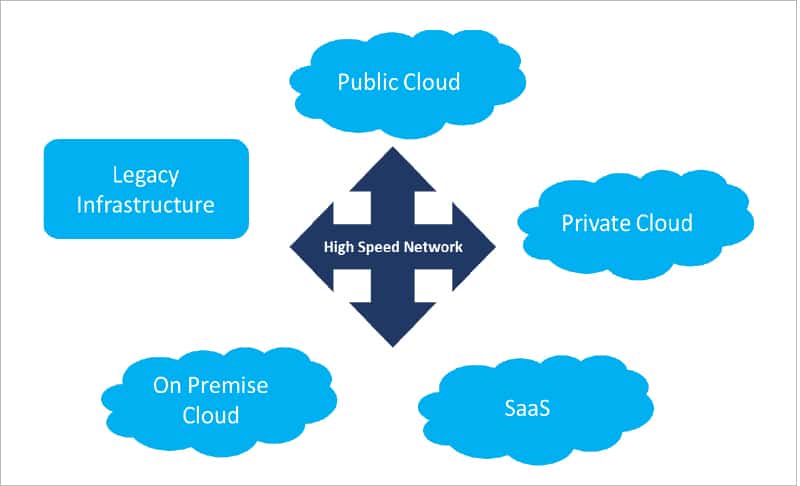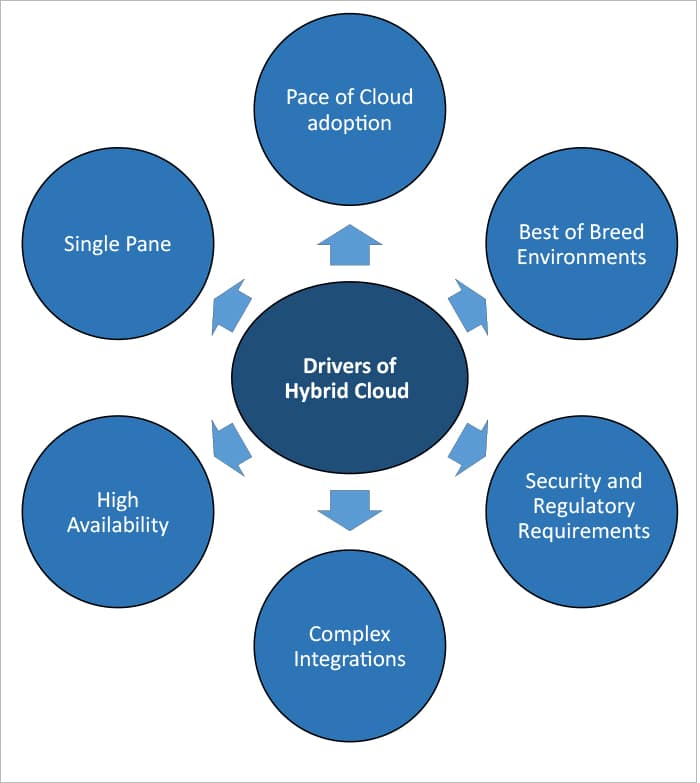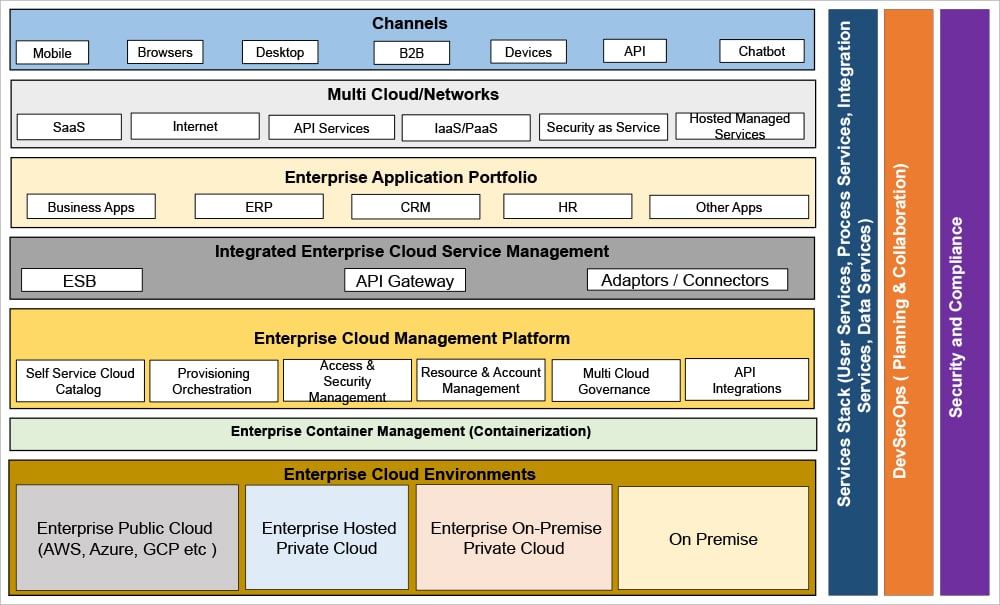The hybrid cloud market is on a high, with businesses discovering its many benefits. Let’s explore what it entails to adopt such a cloud model and why an organisation should consider moving to it.
Enterprises aim at competitive advantage through process agility and innovative business models at low costs. Cloud solutions provide the much needed flexibility to enterprises to develop the capabilities necessary to innovate and seize new business opportunities. Businesses look at a better customer experience, business agility and flexibility, a reduction in hardware and IT staffing expenditure, and improved security, among other things when they decide to shift to the cloud.
According to a report by Allied Market Research, the hybrid cloud market was valued at US$ 96.7 billion in 2023, and is estimated to reach US$ 414.1 billion by 2032, growing at a CAGR of 17.2% between 2024 and 2032. Gartner predicts that by 2025 enterprises will spend more on public cloud services than traditional IT solutions. As per IDC, by 2025, 85% of organisations will see a 35% increase in sustainable efficiencies by using software and cloud-based infrastructures. And according to a Delvens report, the global hybrid cloud market size was estimated at US$ 96.2 billion in 2023 and is projected to reach US$ 278.51 billion in 2030 at a CAGR of 16.4% during the forecast period 2023-2030.
CIOs across industries are busy working with multiple cloud providers, essentially to retain what works and check what to improve across the enterprise cloud estate. One of the fundamental decisions they need to make is how to balance the onsite, remote, public and private elements of that combination. CIOs need to derive a strategy to adopt emerging technologies to provide more business value than before. Interestingly, security concerns regarding adoption of public cloud providers are falling while those regarding vendor lock-in are increasing. Enterprises do not want to put all their eggs in one cloud provider’s basket to minimise their dependency on it.
Important factors that CIOs must consider before promoting a hybrid cloud model across the enterprise are:
- Does the organisation have the right business culture to embrace rapid change?
- What value will the hybrid cloud bring to the business?
- Will it help to lower costs, improve processes and manage security better?
- Is the business ready for the new service model?
- Is it ready to address change management when moving to a hybrid cloud while maintaining business continuity?
- Do enterprises have the right use cases for hybrid cloud adoption? For example, are they using packaged applications, have a disaster recovery setup across multiple geographies, etc.
- What is the volume of requirement for new application development on existing architectures, and for the development of next generation applications?
The hybrid cloud model addresses all these concerns as it offers flexibility, scalability, security, data sovereignty, compliance, and cost-effectiveness based on individual business objectives. Some of the top companies offering hybrid cloud platforms are Amazon Web Services, Google, IBM, Microsoft, Oracle, Salesforce, SAP, Teradata, Alibaba, and Tencent.
The components of a hybrid cloud
The hybrid cloud combines two or more cloud models like on-premises, private cloud, and public cloud, and typically consists of the following (see Figure 1).

Public cloud: Services provided by third-party cloud providers like Amazon Web Services (AWS), Microsoft Azure, or Google Cloud Platform (GCP).
Private cloud or on-premises infrastructure: A cloud environment dedicated to a single enterprise, hosted internally or by a third-party provider.
Hybrid cloud management platform: This platform provides tools and services to manage and orchestrate resources across both on-premises and cloud environments. It ensures seamless integration and consistent policies.
Network connectivity: Secure and high-speed connections, such as VPNs or dedicated links like AWS Direct Connect or Azure ExpressRoute, are used to connect on-premises infrastructure with cloud environments.
Security and compliance: Security measures and compliance policies are implemented across all environments to protect data and ensure regulatory adherence.
| Feature | Public cloud | Private cloud | Hybrid cloud |
| Usage | Anyone can use public cloud services. | A single enterprise uses cloud services. | Cloud services are distributed among private and public clouds. |
| Data access | Virtualisation is used to build cloud services that are provided to the public. | A private cloud resides in the enterprise and behind a firewall, so only the user inside the enterprise can access and manage it. | Sensitive information is kept inside the private cloud, while other services can be hosted using a public cloud. |
| Data storage | Data of different enterprises is stored in a shared environment. | Data of a single enterprise is stored in a private environment. | Businesses can decide where to store data to secure it, making it cost-effective. |
| Data centre | Data centre is located anywhere on the internet. | The data centre location is inside the enterprise network. | Data centre is located inside the enterprises’ network and on the internet. |
| Service management | Cloud service provider controls and manages the services. | Enterprises manage the services as they have their administrators. | Some services are managed by the enterprise, and the CSP manages some. |
| Security | Security is minimal. | High security. | High security. |
| Flexibility | Less flexible. | Less flexible. | Highly flexible. |
| Data recovery | Easily recovers enterprise data. | Data recovery is complicated. | Data is always secured. |
| Performance | Performance is low. | Improved performance. | Better performance. |
| Cost | Cost-effective | Fairly expensive | Cost-effective |
Table 1: A comparison of public cloud, private cloud and hybrid cloud usage
Key considerations and drivers for moving to a hybrid cloud
A hybrid cloud plays a key role in increasing the speed of delivery of IT resources to end users and improving disaster recovery capabilities while improving resource utilisation.
A few factors that must be considered before moving to a hybrid cloud are listed below.
Current state: The current application landscape and infrastructure across the enterprise must be assessed. A complete application portfolio analysis of the enterprise needs to be carried out.
Portfolio rationalisation: Business functions and the applications that are catering to them must be identified and re-engineered based on industry trends. Redundant functionality across applications should be identified and rationalised before moving on to the hybrid cloud.
Application migration: Applications can be migrated ‘to and from’ the data centre and cloud using the hybrid cloud model. Identify the applications that need to remain on-premises or move to a private or public cloud. This can be temporary or permanent depending on the strategy of migration.
Nature of applications: Applications that change frequently need to be moved to the cloud to leverage automated deployment through adoption of DevOps. Applications that handle sensitive data are best retained on-premises. Applications with very high scalability requirements because of varied user load should be hosted on the public/private cloud.
Containerisation: Containerising the applications helps in making them move across public, private, and on-premises clouds, and must be looked at before moving to a hybrid cloud.
Cloud interoperability: Integration between several cloud offerings across multiple cloud service providers and cloud types is key to the success of hybrid cloud adoption.
Figure 2 lists six drivers of hybrid cloud adoption. These are:
Pace of cloud adoption: A big bang approach is not going to fly. Factors that will help decide the rate of cloud adoption are the complexity of the application, data requirements, regulatory and compliance needs, modernisation prerequisites, cost implications, etc.
Complex integrations: There is always a need to connect an application to historical data that resides on the on-premises servers, even though the migration to cloud has happened. Businesses must invest in a good integration strategy before moving to a hybrid cloud. Applications with high integration may need to be co-located to deliver the best experience. Point of delivery applications may be deployed on specialised hardware systems or integrated with machinery that requires applications to be hosted on-premises.
Security and regulatory requirements: Applications with regulatory and compliance requirements need some of the data to reside on-premises. Due diligence is needed to select the right applications for the hybrid cloud.
Best-of-breed environments: The best environment must be chosen for the applications that require special hardware to deliver the functionality at the most optimal cost and effort.
High availability: Applications should be redundantly deployed for high availability across many cloud types to provide business process continuity and disaster recovery.
Single pane, single view: Single pane, single view of all the applications across different cloud models is a must to ensure effective data management, security, and reduced costs.

Hybrid cloud management model
The key components of the hybrid cloud management model (Figure 3) are:
Channels: These are the various mediums through which users interact with the cloud, such as the web and IoT devices.
Enterprise application portfolio: As a first step, the applications that run on the hybrid cloud are categorised. Some of the core business applications are ERP, CRM, and HR systems. Factors like storage, latency, application dependencies and operational complexity need to be considered to decide on cloud adoption. Applications that change/evolve frequently are best moved to the cloud to leverage automated deployment. The next step is to decide on the need to redesign or re-architect an application to use it in the cloud.
Integrated enterprise cloud service management layer: This layer helps in handling all the service requirements, delivering and managing cloud services across the enterprise. It includes all the cloud platforms deployed by the enterprise including public cloud, private cloud, third party hosted environments and on-premises legacy data centres. The policies and frameworks address interconnectivity and integration across multiple cloud components.
- API gateway: This manages and routes API requests, ensuring security and scalability.
- Service gateway: This focuses on managing microservices.
- Adaptors/connectors: These enable integration with various external systems and services.
Enterprise cloud management platform: This platform provisions infrastructure components, platform services components, security and access management, and multi-cloud governance. It offers a self-service catalogue for users that helps them manage their services.
Enterprise container management layer: Containerising the solution makes the services cloud- and platform-agnostic. Container platforms are now available as a service (CaaS) which is robust and highly available, making multi-region deployment possible easily.
Public cloud: Public clouds offer the flexibility of deployment across multiple regions and for varying user loads. They typically have DMZ (demilitarized) and non-DMZ environments with perimeter security implemented through cloud native services. AWS, Azure, and GCP are major public cloud providers.
Enterprise private cloud: This refers to the hardware and software resources located within the enterprise’s premises. Enterprise private cloud addresses the safety, security, regulatory and compliance requirements of the business. These resources are typically connected to the customer’s on-premises/hosted environments through secure dedicated lines to allow secure and faster communication between applications.
On-premises private cloud: This is used to host applications that need a high degree of co-location and controlled access to data and environments, and have regulatory and compliance requirements.
Legacy hardware: Applications requiring specialised hardware and point of delivery applications typically need to be hosted on-premises. They may not need scalability as the load is typically controlled, and if required is managed through vertical scaling of the environments.
SaaS platforms: SaaS applications are typically consumed on a subscription basis. Here, the infrastructure and security are offered by the service provider.

Key open source cloud platforms
Open source cloud platforms can be chosen based on:
- Deployment flexibility
- Ease of operations
- Choice of application stacks
- Language, database and framework support
- Scaling capabilities
- Quality of service
- Tooling for development and operations
- Business fitment
Here are a few popular open source cloud platforms.
OpenStack: OpenStack is open source software for creating private and public clouds, built and disseminated by a large and democratic community of developers in collaboration with users. It is mostly deployed as infrastructure-as-a-service (IaaS), whereby virtual servers and other resources are made available to customers. The software platform consists of interrelated components that control diverse, multi-vendor hardware pools of processing, storage, and networking resources throughout a data centre.
Cloud Foundry: Cloud Foundry is an open platform-as-a-service (PaaS) which provides a choice of clouds, developer frameworks and application services. The platform makes it faster and easier to build, test, deploy and scale applications.
OpenShift: This is Red Hat’s cloud computing PaaS offering. It is an application platform in the cloud, where application developers and teams can build, test, deploy and run their applications.
Cloudify: Cloudify has been developed and designed on the principles of openness to power the IT transformation revolution. It enables organisations to design, build and deliver various business applications and network services. The latest version of Cloudify is 4.3, which introduced a totally new concept for container orchestration with Kubernetes (Kubernetes cloud native orchestration).
WSO2: This PaaS framework from the Apache community provides elastic scalability for any type of service, using the underlying infra cloud. WSO2 is a microservices-based architecture that supports various services, and fosters agility and flexibility with open source.
Apache Cloud Stack: This open source software platform is an infrastructure as a service (IaaS) cloud-computing platform. Various service providers use Cloud Stack to offer public cloud, private cloud and hybrid cloud services.
Eucalyptus: This open source software platform implements infrastructure as a service (IaaS) in a private or hybrid cloud computing environment. It provides quick and efficient computing services. It allows users to deliver their own data centres into a private cloud and hence, extend the services to other organisations. Eucalyptus was designed to provide services compatible with Amazon’s EC2 cloud and Simple Storage Service (S3).
Benefits of hybrid cloud adoption
Enhances business productivity: A hybrid cloud helps speed up business processes, supports collaboration, and provides cost-effective solutions to free up IT budgets for innovative, revenue-generating projects.
Reduces costs: It helps in reducing operating and capital costs, and improves performance, productivity and business agility by offering a flexible, scalable solution.
Flexibility: Enterprises can choose the optimal environment for each workload based on performance, security, and cost, and can easily migrate their workloads to and from different cloud models whenever necessary.
Cost optimisation: A hybrid cloud model allows users to choose from the environment where they want to run their workloads most cost-effectively. By moving non-critical workloads to the public cloud, enterprises can reduce their on-premises infrastructure costs and pay only for the resources they consume.
Reliability: In this model, if one cloud goes down, some functionality will still be available to users from the other deployed clouds. Generally, one public cloud can be used as a backup to another cloud.
Resilience: In a hybrid cloud model, an enterprise can run applications redundantly in both environments, i.e., public and private clouds. Thus, components of a single workload can interoperate and run in both environments.
Risk management: A hybrid cloud helps in mitigating risks with a single, unified, cybersecurity solution.
Managing legacy systems: A hybrid cloud model can bridge the gap between legacy and new systems, helping save costs.
Scalability: Applications can scale infinitely by adopting a hybrid cloud strategy while keeping the core of the business and data secure through on-premises hosting. When an enterprise’s demand exceeds the capacity of the physical data centre, it can transfer the data to the public cloud to access extra capacity and scale.
Disaster recovery and business continuity: Hybrid clouds enable enterprises to create robust disaster recovery plans by replicating data and applications across multiple environments.
More and more enterprises are embracing a hybrid cloud model as part of IT strategy. However, to fully realise the potential of hybrid cloud adoption enterprises must carefully navigate the challenges such as complexity, security, and the required skillsets.
A hybrid cloud is not just about delivering cost savings. It is about the enterprise becoming more agile, efficient and productive. The good news is that enterprises of any size can adopt a hybrid cloud model for cost-efficient delivery of business applications.
Disclaimer The views expressed in this article are that of the author. HCL does not subscribe to the substance, veracity or truthfulness of the said opinion.
















































































